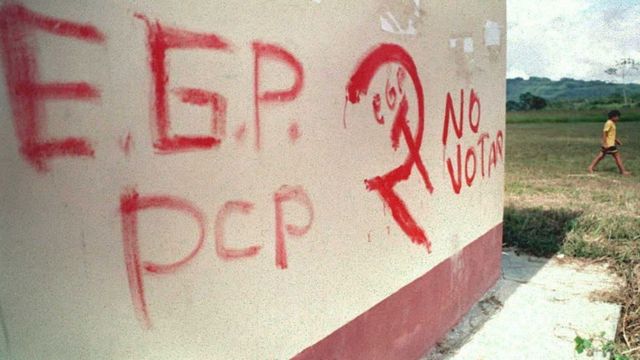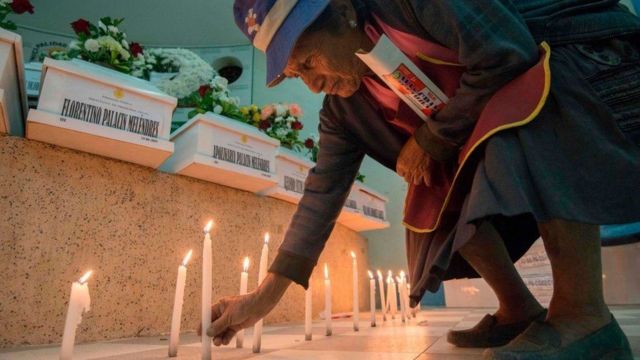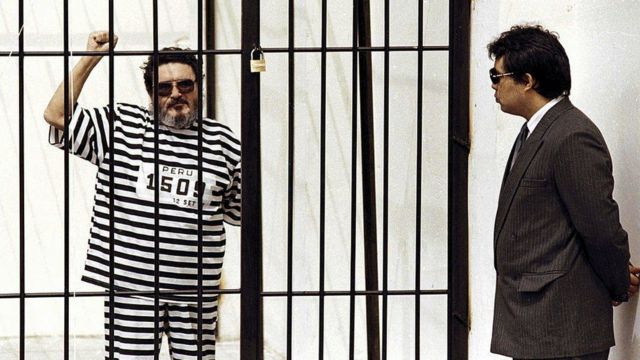- Pierina Pighi Bel (@PierinaPighi)
- BBC News World
In the early morning of May 17, 1980, five hooded youths entered a polling place in Chuschi, a small town in Ayacucho, in the southern highlands of Peru, and burned the amphorae prepared for the presidential elections the following day.
The apparently small incident received almost no media attention. But now it is remembered every year as the first of thousands of attacks and murders he committed. Shining Path (SL), whose leader and founder Abimael Guzmán passed away this Saturday, during the war that it unleashed against the State in Peru and that according to some calculations left 69,000 dead and missing.
The conflict was the longest and most deadly that the country has suffered in its republican life.
SL chose this route of armed violence to seize power following, according to its leaders and its members, a Marxist-Leninist-Maoist ideology.
The “Maoist” factor it differentiated SL from other leftist groups and guerrillas in Peru and Latin America.
“Maoism was the most important thing for Abimael Guzmán and if you read his writings, he is always talking about Mao,” he tells BBC Mundo. Orin Starn, professor at Duke University, United States, and co-author of the book “Shining Path: Love, Madness and Revolution in the Andes”.
How did this ideology take root in Peru and why was it so lethal?
Division in international communism
The origin of Maoism in Peru is evidently very far from the small town of Chuschi.
In the late 1950s and early 1960s, the Soviet Union (USSR), under the government of Nikita Khrushchev, adopted the policy of peaceful coexistence with capitalist countries and opened up to the possibility of implementing socialist systems peacefully .
This position of the USSR divided the communist movements of the world and also of Peru.
On the one hand, there were the groups that accepted the peaceful – pro-Soviet – terms, and on the other, those that still claimed the armed path to socialism.
The latter, who continued to defend the need for war, aligned themselves around the Chinese Communist Party (CCP), under the command of Mao Tse Tung.
“Maoism was a global phenomenon in the 1960s. It was fresh and exciting and promised revolution and that was a big part of its appeal to young people, who weren’t interested in old-fashioned Soviet communism, which was perceived as the establishmentStarn says.
“In the international romanticization of Mao, people either did not know or were ignorant of the atrocities that his government was committing,” he adds, clarifying that in Peru Maoism was not “really associated with terror until the conflict began in 1980.”
In this country, about half of the communists, including members of the SL, remained in the pro-Chinese faction.
“Peru was the only country in Latin America where the Maoist split was important,” details the final report on the armed conflict from Peru’s Truth and Reconciliation Commission (TRC).
The Peruvian pro-Chinese side was also subdivided into smaller groups, but not all took up arms. Do youWhy did the Shining Path follow this bloody path?
China travel
As many Maoists in Latin America, Africa and other places did at the time, Guzmán traveled to China twice: in 1965 and then in 1967, already in the middle of Mao Tse Tung’s Cultural Revolution, which was a campaign of repression, political purges, exile, executions and forced labor for millions of Chinese.
The aim was to eliminate capitalist influences and “bourgeois thought”.

The second time, Guzmán traveled with his wife, Augusta La Torre, who until her death in 1988 was SL’s number two.
The war that both unleashed with the organization was violent because the Cultural Revolution was the most radical phase of Maoism, explains the TRC.
“They considered that instead of having been a disaster, an immense historical tragedy, the Cultural Revolution had been one of the stellar moments of humanity,” says Peruvian journalist Gustavo Gorriti, author of the book “Sendero”, to BBC Mundo.
On these trips to China, both they trained in ideology and war tactics.
When they returned to Peru, they wanted to put their Maoist beliefs into practice. What did they consist of?
“Semi-feudal” countries
One of the main dogmas that SL took from Maoism was that in the “semi-feudal countries” or the so-called “third world” —which was how they described Peru— power had to be taken through a “Prolonged people’s war from the countryside to the city”, details the CVR.

SL believed that Peru and China were semi-feudal countries because “there was a bit of capitalism, but the majority lived in the countryside, on backward estates,” says Antonio Zapata, author of the book “La guerra senderista. The enemies speak ”, to BBC Mundo.
“So they had the idea that Chinese society was similar to that of Peru and from there they deduced that the revolution would be similar. That is why they adopted the ideas of China ”, says Zapata.
This “revolution” or armed route obviously implied violence, which was “like a Pandora’s box,” he adds, because “the violence completely overflowed” in the country.
From the “semi-feudal” context, Maoism considered the countryside to be the “main scene” of war or armed struggle, and the cities, a complement.
“Marx thought that industrial workers would have to lead the revolution. Mao’s innovation in the face of Marxism was to say that poor peasants can be revolutionaries. Peru in the 1960s was also a rural country, ”says Starn.
“In addition, José Carlos Mariátegui (an important Peruvian Marxist thinker and writer and founder of the Peruvian Socialist Party), had the idea that the problem in Peru it was the problem of the land, of the indigenous peasants. Maoism resonated with that idea, ”he adds.
Meanwhile, “other countries in Latin America were a little more urbanized and Mao’s model did not seem very applicable as in Peru,” says Starn.
But these beliefs were not the only ones they adopted.
“Gonzalo Thought”
Another feature of the Mao Cultural Revolution that SL took was the cult of personality, that in the Peruvian case fell on Guzmán.
The leader called himself “Chairman Gonzalo” and his group considered him as the “fourth sword of Marxism” in the world, after Marx, Lenin and Mao, and as the “most qualified interpreter” of the Chinese president, says Gorriti.
Lenin and Mao were responsible for many brutalities. But both of them and Marx were great historical figures. There was a delusional idea that somehow Guzmán was on the same level, “says Starn.
SL started calling his set of ideas “Gonzalo Thought”, which was Guzmán’s interpretation or application of Maoism to the Peruvian reality of the 60s, 70s and 80s.
“They tried to insert all that orthodoxy into the Latin American reality and began to speak of Marxism-Leninism-Maoism-Gonzalo Thought,” Zapata points out.

“Gonzalo Thought” simplified or made Maoism more violent, for example, by giving a universal character to the people’s war, which for Mao was valid only in backward (semi-feudal) countries, says the TRC.
But what did Guzmán add to Maoism? “Not much,” says Starn.
Armed conflict
With all these and other ideas in the making or already consolidated, SL began the armed struggle in 1980, despite the fact that the Cultural Revolution had ended, that MaoTse Tung had already been dead for four years and that Deng Xiaoping had succeeded him, who promoted a series of reforms of economic opening in China, away from the communism of its predecessor.
Meanwhile, other Maoist groups had decided to take legal avenues of political participation.
The Peruvian police captured the leadership of SL, including Abimael Guzmán, on September 12, 1992. The group was convicted of crimes of terrorism and its members imprisoned.
And that’s how he died 30 years later, behind bars of the maximum security penal center of the Callao Naval Base, “Comrade Gonzalo”.
eltiempolatino.com